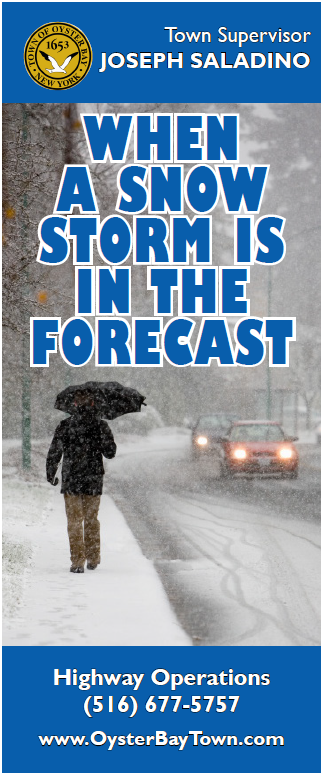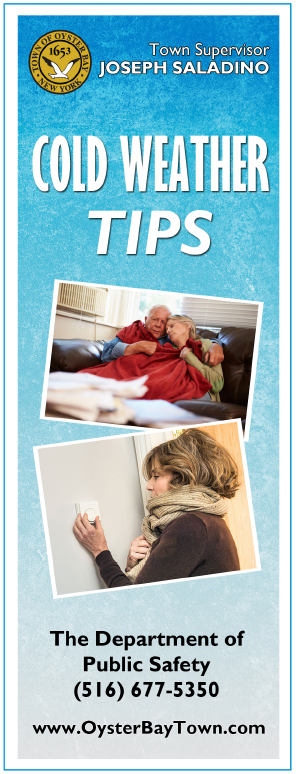
Emergency Operations Center > SNOW STORM SAFETY GUIDE
Emergency Operations Center (516) 677-5757
Public Safety Emergency Management (516) 677-5350
A Message from Town Supervisor JOSEPH SALADINO
The Town of Oyster Bay is responsible for plowing snow from 750 lane miles of public streets. Our goal is to keep all streets open for emergency vehicles, traffic moving and to return roadways to a safe condition for winter travel, as quickly as possible. Your safety is our top priority!
Snow response operations involve the coordination of hundreds of trucks, pieces of equipment and employees. We pretreat roads before the storm to prevent ice. Once snowing, plow operators are instructed to “open up” each street- plowing a path down the center of the road for first responders to reach residents at all times. Plow operators return – making multiple passes to clear intersections and plow curb-to-curb.
To best plow your road, we ask that you move cars off the street and into your driveway, a neighbors driveway (with permission) or onto the sidewalk temporarily. You can also avoid shoveling the end of your driveway several times by waiting until the plow operation is complete. You can sign up for Smart911 by CLICKING HERE and providing us with your contact information. You can also call us at (516) 677-5350 and request the form to be filled out by you and returned to the Town in order to add your contact information to the Town’s emergency contact system.
For residents with Special Medical Needs- any resident who is a dialysis patient should register with the Town’s Highway Department so that your address can be placed on a priority snow removal list. This will ensure that should a medical emergency take place, a medical emergency service vehicle can safely access your residence. To be added to the list or to check and see if you are on the current emergency medical list maintained by the Town’s Highway Department, please feel free to call (516) 677-5757.
SAFETY TIPS, RULES & REGULATIONS DURING A SNOW STORM
When the National Weather Service predicts a snowfall of three inches or more, or when the Town Supervisor declares a snow emergency, all cars must be removed from designated snow emergency routes (Sec. 17-261).
- Please remove cars from streets wherever possible. Arrange with neighbors to make use of driveways that are not being utilized. This will help get your road plowed more quickly and efficiently.
- As an alternative to removing cars from the street, in odd-numbered years, cars should be parked on the odd-numbered side of the street and in even-numbered years, they should be parked on the even-numbered side of the street.
- Please DO NOT blow or shovel snow from driveways or sidewalks into the street. It is a hazard to all vehicles.
- Remove all obstacles from the roadway and utility strip (grassy area between the street and public sidewalk) in front of your home. This includes all sports equipment (i.e. hockey/soccer nets, basketball hoops, skateboard ramps and rails). Removing these items will help protect the safety of our snowplow operators and will help eliminate damage to your property.
- Before the snow falls, remove debris from street catch basins. Once the snow begins to melt, it will flow freely into the basin instead of flooding streets and possibly turning to ice.
- When a snow storm strikes, avoid driving. If you must drive, fill your gas tank and stock your vehicle with blankets, a shovel, flashlight and batteries, quick energy foods, a brightly colored cloth to use as a flag, booster cables, windshield scraper, set of tire chains, distress flares, first aid kit and a small sack of sand to generate traction. Let someone know your travel plans and estimated time of arrival.
- Be careful at intersections when snow is on the ground. Heat emanating from idling cars melts the snow beneath the cars. The melted snow turns into icy patches and unsuspecting motorists skid when attempting to stop.
- When snow removal equipment is at work with lights flashing, stay clear. This equipment moves slowly.
- After a snowfall, please clear all fire hydrants of snow accumulation.
FLOOD PREVENTION TIPS
Deep snow can melt into a lot of water. Deep snow very rarely causes flooding by itself. Often, heavy rain and rapid warm-ups combine with rapidly melting snow to cause major flooding problems. Here are some things you can do to be prepared for heavy rains and rapid warm-ups to prevent damage to your property and flooding:
- Keep gutters clear of leaves and debris to prevent ice dams.
- Ensure that drains in outdoor basement stairwells and window wells are functional. Remove snow from these areas after the storm has ended. Melting snow can lead to water damage and moisture intrusion.
- Remove outdoor flower or window boxes hanging on a home’s exterior because snow can accumulate and melt against the building exterior causing moisture intrusion.
- Ensure that skylights and other roof openings have proper weather stripping or gaskets around the perimeter to keep snowmelt from seeping through.
- Remove icicles hanging from gutters and over walkways.
- Keep your attic well ventilated to maintain a temperature close to that of the outdoors and minimize risk of ice dams forming. A warm attic melts snow on the roof, causing water to run down and refreeze on the roof’s edge, where it’s much cooler. If ice builds up and blocks water from draining, water is forced under the roof covering and into your attic or down the inside walls of your house.
- Check storm drains near your home and business and clear away leaves, debris and heavy snow. Clogged grates are often the reason a street floods under rainstorm or rapid snow melt conditions.
- Please do not put trash bags into the street as this can be hazardous to traffic and also cause flooding from clogged storm drains.



